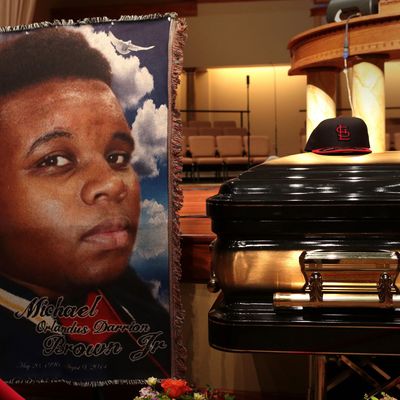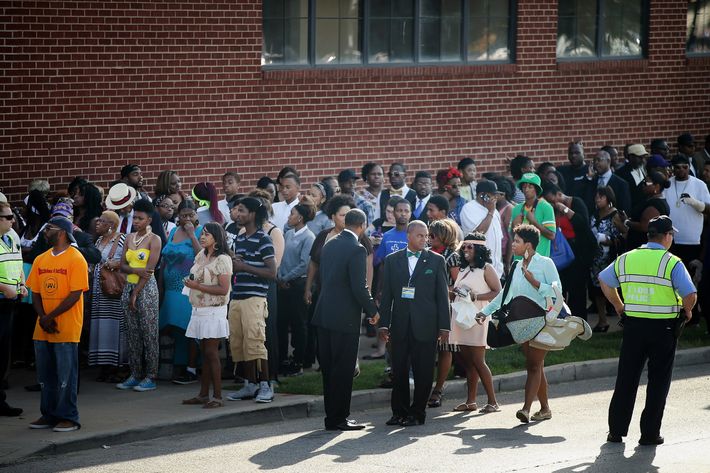
Yesterday in St. Louis, the family of Michael Brown Jr. laid the 18-year-old to rest, after two weeks of protests and violent uprising following his death — as an unarmed black man shot six times and killed by a white police officer — in a funeral the whole world was watching. Media tents lined the street outside Friendly Temple Missionary Baptist Church on Martin Luther King Jr. Boulevard, as reporters from Los Angeles to Italy and China to St. Louis interviewed the crowd. Spike Lee was there, and MC Hammer, and Wesley Snipes, along with the Reverends Al Sharpton and Jesse Jackson, Bishop T.D. Jakes (who got the biggest applause of all), and family members of other black men who’d been killed by whites who’d seen them as threats: Trayvon Martin, Sean Bell, Oscar Grant, Emmett Till — and even Martin Luther King’s son and daughter, Martin Luther King III and Reverend Bernice King.
But, after emerging from that moving, three-hour ceremony, the coverage of the funeral on the news and on Twitter seemed far from a full portrait of this rich and complex national event. Here’s a taste of what you may not have seen or heard …
1. The line to get in, which started forming at 7 a.m., three hours before the service, was like an incredibly friendly intergenerational mixer: Young men with dreadlocks and red polo shirts offering to save the spots of old ladies in church hats who needed to go lean against a light pole in the shade. In my immediate vicinity were a member of the New Black Panther Party; a man in a white and orange dashiki dress; a 79-year old St. Louis woman who says she still gets stopped by police; a reporter in his late 70s from Gettysburg, Pennsylvania, who attended Dr. King’s funeral and the Rodney King trial; a clinical psychologist who’s gone to Ferguson every day to help the residents of Canfield Green cope with curfews and anger and nightmares from seeing Brown’s body in the street; and a young businessman from St. Louis who thought that all the attention on Ferguson, and the money coming into the town from the outside, was going to bring in a wave of gentrification: “There’s a Starbucks coming, believe me.”
2. Jesse Jackson’s arrival was met with craned necks, particularly because the people walking in with him were singing “We Shall Overcome,” but it was Bishop T.D. Jakes of the evangelical African-American megachurch the Potter’s House who got a standing ovation and shrieks of delight. In fact, when Jackson arrived, Freida Wheaton, a St. Louis gallery owner, rolled her eyes: “So what? We’re here, too. And we’re gonna be here.”
I didn’t hear a single person mention having read, or being aware of, the New York Times “no angel” article.
3. Most of those guys selling T-shirts outside the funeral that caused MSNBC’s Trymaine Lee to send an astonished and outraged tweet weren’t profiteers. One vendor, Reggie Jones, came from Charlotte and has been in Ferguson for a week, asking $10 but taking as little as $5 and donating the proceeds to the family. Yashua Anton, 42, who was selling “Hands Up, Don’t Shoot” shirts in a pinstripe suite, had come from Chicago, where he runs a printing business catering to Historically Black Colleges. Trayvon Martin’s father, Tracy, is his fraternity brother, which is how he met Mike Brown Sr., who had given Anton his blessing to come. Anton had already made a lump sum donation to the funeral and was planning to donate a portion of the $4 he made on each shirt to the family’s legal fees. More than money, though, Anton, Jones, and their associates see the T-shirts as a public good — a form of productive venting, and a way to keep the cause visible.
4. There were, however, a group of T-shirt peddlers who were there just for profit — notably the ones selling the “I Survived the Ferguson Riots of 2014” shirts. As vendor Jay Michaels, 25, said, “Some people might think it’s wrong, but we’re not doing nothing wrong.” If the family cared, he said, they would have said something. And as for the bad look of making money off a tragedy (he estimated he’d moved $5,000 worth of shirts, at $10 apiece), he said, “I mean, it’s not only a tragedy, though.” He gestured at the huge crowds and the media tents and the dozens of white reporters interviewing the black people of St. Louis in the middle of the street. “Come on! I don’t know what to call it, but it’s not just a tragedy anymore.”
5. The church is enormous — with 2,500-capacity sanctuary that makes New York’s Beacon Theater look small — and equipped with state-of-the-art technology. Two large TV screens inside the sanctuary showed the ceremony, and a live-stream was going out to four other spillover venues that brought the local capacity to around 5,000. The church is a 16-minute drive from Ferguson and save for the church, the neighborhood looks equally desolate.
6. One elderly woman in the crowd, in a sparkly knit hat and a sparkly shawl, brought her own tambourine and maracas. She stood up and played them whenever the spirit moved her, which was often.
7. Brown’s mother, Lesley McSpadden, and father, Michael Brown Sr., didn’t speak, but they did write touching notes to him in the funeral program. “I want you to know that you were the purpose of my life/ Out of everything that I did — it was you that I did right,” read McSpadden’s. Brown’s obituary in the program touted his love of PS4 and Xbox.
8. The entire left side of the sanctuary was reserved for 600 members of the Brown family party. The group included eight street preachers who became the “first responders” to the crime scene, praying and pacing in a line between the police and angry Ferguson residents for nearly five hours.
9. Despite the family’s request that people not take pictures during the ceremony, lots of people did.
10. There were moments of pure chaos and joyous reverie, particularly when the choir broke out into rousing songs like “Praise Him” and “Every Praise Is to Our God,” and the entire building erupted in raised voices, raised hands, and stomping feet. Strangers grabbed strangers hands, or gave their neighbors hugs. Where I was sitting, every single person knew every word.
11. The church’s pastor, Michael Jones, asked speakers to “bless this family with brevity,” because they had made a promise to the school district that they would clear the streets in time for buses to get through without any delays that might endanger children trying to get home.
12. Relatives referred to Michael by his various nicknames: Big Mike, Mike Mike, and the Gentle Giant.
13. Various family members came to the podium to offer tribute. Michael’s cousin Bernard O. Ewing wore sunglasses and shook as he told the room, “I would be lying if I said to you I’m not still aching in my heart, and I don’t have revenge on my heart, but I can’t be no fool.” He concluded, “I love you, Mike. That’s all I have to say.”
14. Most touching were the remarks from his stepmother, Cal Brown, who talked about the three years she’d spent with Mike since marrying his father, often talking about God and the future — he’d wanted a family and had been excited to be a freshman at Vatterott College, which started classes two days after his death. “He was truly curious about what God had to offer. About a month ago, we both completed the first book of Genesis and Revelations.” A week before Mike died, she said, she went into the hospital and Mike told his father that he didn’t think Cal would make it. When she got out, she asked him why he’d said that, “And he said, ‘because I’ve been dreaming of death. I’m seeing pictures of death.’ He said, ‘I see bloody sheets hanging on the clothesline.’ And it truly touched my heart. When I went out there and I saw Mike Mike, that’s exactly what he was laying on, so he pretty much prophesized his own death.’”
15. Religion cannot be separated from the narrative of how black residents of Ferguson and surrounding communities are coping with Brown’s death and its aftermath. The funeral was named Michael’s “Home Going Service.” His cousin Bernard Ewing and another cousin, Eric Brown, repeated what has become a healing refrain for this family, the story of how two weeks before his death, Michael accepted Jesus as his savior. “He said he was saved!” said Ewing, to a roar from the crowd. Both friends and family spoke of how in the last few weeks of his life, Michael had told them that he was going to be famous and that the whole world would know his name.
16. Surprisingly, Reverend Al Sharpton, who delivered the final respectful and galvanizing eulogy, referenced religion the least, instead asking attendees not to get so caught up in the divine that they forget what had happened in St. Louis. “It is out of order for parents to bury their children,” he said, “We should not sit here today and act like we are watching something that is in order. In all of our spiritual celebration, let us not lose sight that this young man should be doing his second week in college.”
17. So many people crowded the aisle of the church taking pictures of Michael’s casket or just cluelessly trying to get out that pallbearers had to wait for five minutes amid the crowd before reaching the hearse.
18. Crowds were so huge outside that the processional had to stay in the parking lot for nearly half an hour before leaving for the cemetery. A couple of young women draped themselves over the hearse, weeping and pounding on the windows. “He’s going home! He’s going home!” one cried. “Lord, what is that girl doing?” laughed another young woman exiting the building. “We don’t all act like that. It’s a little embarrassing.”
19. The mourners sang at the cemetery, too — “I’ll Fly Away” and “We Shall Overcome.” Michael Brown Sr. released a white dove as his son’s casket was interred, as a final good-bye.






























